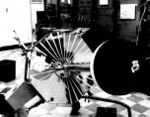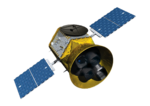Astronomy:Explorer 28
From HandWiki
 | |
| Operator | NASA |
|---|---|
| Website | [1] |
| Mission duration | ~2 Years |
| Spacecraft properties | |
| Dry mass | 58 kilograms (128 lb) |
| Power | Solar Panels |
| Start of mission | |
| Launch date | 29 May 1965 |
| Rocket | Delta |
| Launch site | Cape Canaveral Air Force Station |
| End of mission | |
| Last contact | 12 May 1967 |
| Decay date | 4 July 1968[1] |
| Orbital parameters | |
| Reference system | Geocentric |
| Regime | LEO |
| Eccentricity | 0.71617 |
| Perigee altitude | 32,290 km (20,060 mi) |
| Apogee altitude | 227,456 km (141,335 mi) |
| Inclination | 53.6° |
| Period | 107.6 minutes |
| Instruments | |
| Radio Beacon, Langmuir probe | |
Explorers | |
Explorer 28 (or IMP-C) was a satellite launched in May 1965 to study Space physics. It was powered by chemical batteries and Solar panels. There were 7 experiments on board, all devoted to particle studies. Performance was normal until mid-April 1967, when intermittent problems began. It stayed in contact until May 12, 1967, when contact was lost. The orbit kept going lower and lower until it re-entered on July 4, 1968.[2]
References
External links


